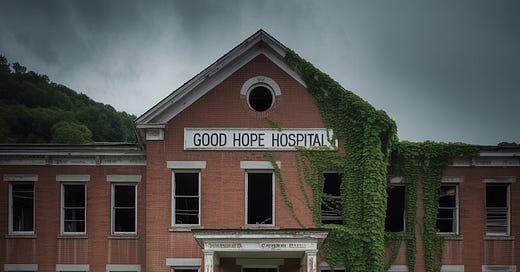Summary
Trump's proposed healthcare cuts and regulatory rollbacks are likely to disproportionately harm his own supporters, creating a significant political paradox. The evidence shows that Trump voters rely heavily on the very programs targeted for cuts—including Medicaid, Medicare, disability benefits, and environmental protections—often at higher rates than his political opponents.
Healthcare Program Dependencies
Medicaid: A Red and Blue State Issue
Despite the perception of Medicaid as a "welfare program," Trump supporters constitute a substantial portion of its beneficiaries 1. More than one in four Medicaid beneficiaries under age 65 are Republicans or lean Republican (27%), including one in five (19%) who identify as MAGA supporters 1. Among adults who purchase their own health insurance through ACA Marketplaces, Republicans make up 45% of enrollees, with about three in ten (31%) identifying with the MAGA movement 1.
Polling reveals that Trump voters themselves oppose Medicaid cuts, with 67% (43% wanting to keep spending the same and 24% wanting to increase it) opposing reductions 2. Only 36% of Trump voters favor cuts to the program 2. Focus groups of Trump voters on Medicaid explicitly opposed cutting the program to pay for tax cuts, with one Nevada voter stating: "I don't make much money to get my taxes affected by that. It would hurt my Medicaid" 3.
Geographic Distribution of Impact
The geographic reality further complicates the political calculus. Of the more than three million Americans who signed up for Obamacare coverage in 2025, 82% live in states that voted for Trump 4. Rural areas and red states that strongly supported Trump would be disproportionately affected by healthcare cuts 56.
Analysis shows that Republican districts often have some of the highest Medicaid enrollment rates in the country 6. In rural Kentucky, where Representative Hal Rogers represents a solidly Republican district, more than 40% of the population relies on Medicaid 6. Similar patterns exist across Trump-supporting rural areas nationwide 6.
Rural Hospital Crisis
Immediate Threats to Trump Strongholds
Over 300 rural hospitals are at risk of closure due to proposed Medicaid cuts, with many located in states that strongly supported Trump 78. These hospitals serve communities where Trump voters are concentrated, particularly in Kentucky, Louisiana, Alabama, Tennessee, and West Virginia 8.
Rural hospitals are already struggling, with 50 fewer operating in 2023 than in 2017 7. The proposed $800 billion in Medicaid cuts would push these financially vulnerable institutions over the edge 910. As one expert noted, "It's very clear that Medicaid cuts will result in rural hospital closures" 10.
Disability and Social Security Benefits
Trump Voters and Disability Programs
Social Security Disability Insurance (SSDI) recipients are disproportionately concentrated in Trump-supporting areas 11.While 45% of Americans live in counties that voted for Trump, 54% of disabled workers and their dependents live in such counties 11. These include rural areas, agricultural regions, and Rust Belt communities with higher rates of injury from manual labor—all regions that strongly supported Trump in 2016 11.
The proposed $70 billion in cuts to SSDI over ten years would primarily affect Trump's base, contradicting his campaign promise not to cut Social Security 11.
Environmental and Regulatory Impacts
Rural and Working-Class Exposure
Environmental deregulation and reduced food safety oversight disproportionately affect rural and working-class communities where Trump draws significant support 1213. These communities often lack resources to protect themselves from environmental hazards and rely more heavily on government safety standards 12.
Minority communities, while not Trump's primary base, face the most severe consequences, experiencing nearly eight times higher rates of pediatric asthma and 1.3 times higher risk of dying prematurely from pollutant exposure 12.However, rural white working-class communities also face increased health risks from deregulation 14.
Demographic Contradictions
Income and Healthcare Dependency
While Trump voters overall have higher median incomes than the general population, significant portions of his coalition depend on government healthcare programs 15. Among Trump supporters, approval for his healthcare policies was weakest among lower-income respondents, with only 65% of those earning less than $15,000 annually approving of his healthcare approach 16.
The "Free Marketeers" segment of Trump voters (25% of his coalition) are more financially secure and less dependent on government programs 17. However, other significant portions of his base, including "American Preservationists" (20%) who lean economically progressive, and working-class supporters, rely heavily on the programs targeted for cuts 17.
Political Implications
Voter Awareness and Opposition
Polling shows that 69% of Trump voters view Medicaid as "an important source of health coverage for people who could not otherwise afford healthcare" rather than as a wasteful welfare program 18. When informed about potential cuts, 52% of Trump voters express unfavorable views toward Republicans pushing for large Medicaid reductions 18.
This creates a significant political vulnerability, as many Trump supporters may not realize the programs they depend on are targeted for elimination or reduction. The disconnect between campaign rhetoric and policy reality could lead to voter backlash once the effects become apparent.
Conclusion
The evidence overwhelmingly indicates that Trump's healthcare cuts and regulatory rollbacks will harm his supporters more than his opponents. Rural hospitals serving Trump strongholds face closure, Medicaid beneficiaries in red states risk losing coverage, and working-class communities dependent on disability benefits and environmental protections face reduced support. This creates a fundamental contradiction between Trump's political coalition and his policy agenda, potentially undermining support among his most vulnerable voters who depend on the very programs his administration seeks to eliminate.
Sources
https://www.newsmax.com/politics/poll-medicaid-donald-trump/2025/03/07/id/1201916/
https://www.kff.org/from-drew-altman/trump-voters-on-medicaid-on-medicaid-cuts/
https://www.newsweek.com/most-obamacare-applicants-donald-trump-states-2006228
https://www.nytimes.com/interactive/2025/02/27/us/politics/medicaid-enrollment.html
https://www.cbsnews.com/news/medicaid-cuts-rural-hospitals-republican-states-democrats-say/
https://kffhealthnews.org/news/article/rural-hospitals-battered-by-big-beautiful-bill-researchers/
https://qz.com/679589/trump-voters-earn-more-and-are-better-educated-than-the-typical-american
https://fivethirtyeight.com/features/trumps-health-care-bill-could-cost-him-working-class-voters/
https://www.voterstudygroup.org/publication/the-five-types-trump-voters
https://www.protectourcare.org/wp-content/uploads/2025/02/POC-Hart-Poll-Press-Briefing.pdf
https://www.pbs.org/newshour/health/a-closer-look-at-who-relies-on-medicaid
https://www.thirdway.org/memo/the-impact-of-house-gop-health-care-efforts-on-trump-voters
https://www.kff.org/medicaid/issue-brief/medicaid-expansion-is-a-red-and-blue-state-issue/
https://www.kff.org/status-of-state-medicaid-expansion-decisions/
https://www.newsweek.com/map-shows-states-most-impacted-republicans-plan-medicaid-benefits-2069129
https://sanantonioreport.org/study-younger-veterans-more-likely-to-be-republicans-than-democrats/
https://news.northeastern.edu/2024/11/05/voter-demographics-interactive-tool/
https://www.finance.senate.gov/imo/media/doc/rs_5_point_war_on_seniors.pdf
https://whyy.org/articles/voters-with-disabilities-challenges-presidential-election-2024/
https://kffhealthnews.org/news/article/republican-trump-voters-health-care-government-role/
https://www.pewresearch.org/short-reads/2024/11/13/what-trump-supporters-believe-and-expect/





